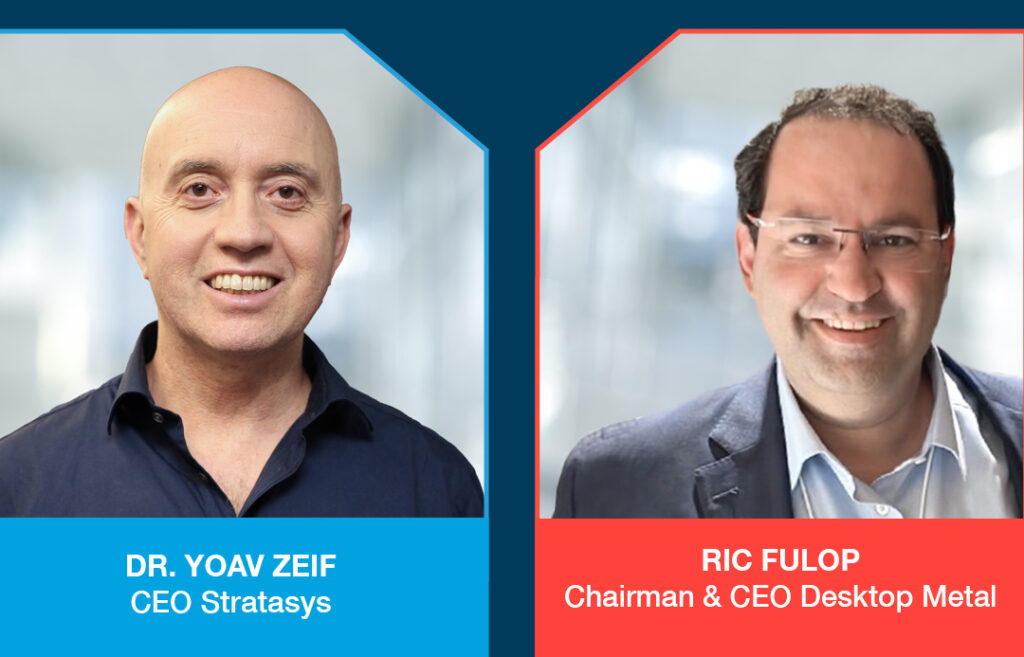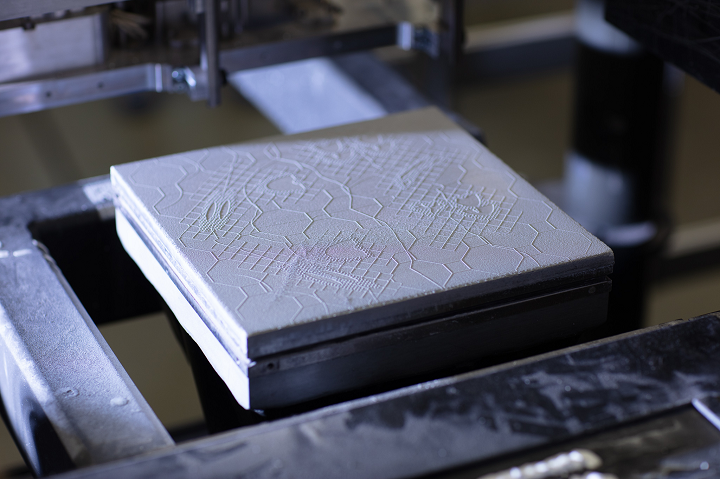As a maelstrom begins to form around the merger of Stratasys (Nasdaq: SSYS) with Desktop Metal (NYSE: DM), company CEO Yoav Zeif is at the helm, steering the ship through troubled waters with the goal of completing its acquisition. Both Zeif and Desktop CEO Ric Fulop will be participating at Additive Manufacturing Strategies in February 2024, where we will hopefully be able to gain insight into the future of whatever business entity results from the current activity. Until then, Zeif was able to take some time to speak to 3DPrint.com about the merger.
Zeif’s Journey to Stratasys

Stratasys CEO Yoav Zeif.
Zeif hails from the prestigious consulting group, McKinsey & Company, where he was a senior associate specializing in agrochemicals, telecom, and banking at the Tel Aviv office from 2003 to 2007. He was also a fellow of the McKinsey Global Institute in San Francisco.
He eventually went on to work as Senior Vice President of Products and Marketing at Makhteshim Agan Industries. Now known as Adama Ltd. and owned by the world’s largest chemical company, ChemChina, the firm is a major producer of pesticides. Zeif then moved to Netafim, the world’s largest maker of micro-irrigation solutions, where he became President of the Americas Division, Head of Product Offering, and Chief Commercial Officer. After two more years at McKinsey’s New York office, Zeif took the reins of Stratasys. When we asked how this last had prepared him for entering a new sector, Zeif relayed:
“It’s really about focus and discipline. I joined Stratasys at the beginning of the pandemic – a crazy time to join! But it ended up being a good time to really develop a focused strategy for us going forward. We wanted to have a clear North Star to lead 3D printing, to address the manufacturing opportunity, starting with the polymer opportunity, and then to position ourselves to lead in additive manufacturing beyond polymers. And since then, it’s been about being disciplined and about sticking with that strategy. We’ve also been disciplined about the acquisitions and investments we’ve made along the way and ensuring they are each effectively integrated into the company. It is a huge advantage to have the best customers in the world to advise us along the way, to really tell us what they need, where the opportunities are, and how we can consistently do better. Making sure we deliver for our customers is a huge motivator for me as I know it is for our Stratasys team around the world.”
Merging with Desktop Metal
According to a filing with the U.S. Securities and Exchange Commission, Stratasys and Desktop have been in discussions related to a possible merger dating back to at least 2021. Zeif began by highlighting how a combination with Desktop Metal fits into a larger goal of the company to scale up to mass production.

“When we set our business strategy after I joined the company in 2020, our focus was on additive manufacturing leadership, particularly in mass production. At that time, we needed to focus first on improving the performance of our existing PolyJet and FDM offerings, and then expanding our capabilities to address other compelling polymer opportunities. We feel great about the results we’ve achieved since then,” Zeif said. “But we knew all along that having a metal manufacturing solution would ultimately accelerate our strategy. Metal end-use parts is the fastest growing segment of our industry, and partners and customers have been looking forward to Stratasys having such an offering. Having achieved key internal milestones on our polymer leadership journey, the time is right to broaden our portfolio.”
In 2018, Stratasys was all-but-ready to go to market with a metal technology developed internally. The process would combine its proprietary inkjet technique with a sintered powder printing method; however, this Layered Powder Metallurgy technique was never commercialized.

A photo of Stratasys’s Layered Powder Metallurgy. Image courtesy of Stratasys.
When Zeif joined the company, Stratasys performed a strategic review and determined that it did not have a metal 3D printing solution that was sufficiently differentiating and ideal for production AM. In turn, the company focused initially on building on its strengths in polymers. As for metals, Stratasys determined that it needed something high-volume that could already be found in the market.
“While we announced this combination a few weeks ago, we’ve been working on it for quite some time. Stratasys has been interacting with Desktop Metal for eight years and began reviewing its metals technology more than two years ago. We extensively analyzed the metal landscape and came away convinced that Desktop Metal has the best and most advanced metal additive manufacturing technology for mass production,” Zeif said.
Transforming the AM Industry
The executive did not acknowledge any pressure from Nano Dimension (Nasdaq: NNDM) in its decision to announce a merger at this time. Instead, he highlighted the fact that conversations with Desktop Metal about joining forces two years back. This wouldn’t be surprising, given that Stratasys was an investor in Desktop. Though not everyone would agree on a merger between the two, it can’t be denied that a combination of the two would instantly expanding their portfolios greatly.
“Quite simply, leading the AM industry into mass production: this combination will create a true additive manufacturing powerhouse that can deliver a full set of solutions from design to production, across a wide range of materials, including polymer, metal, sand, and ceramic,” Zeif said. “We will be able to deliver these solutions for our customers around the world through the strongest go-to-market organization in the industry. That means more value for our customers and it will give us profitable growth for years to come.”

Stratasys’s Selective Absorption Fusion technology features the use of a counter-rotating roller, which coats powder layers onto the print bed and applies absorber fluid, which images the part layers. These imaged layers are then fused together when an infrared (IR) lamp is passed over the whole print bed. These processing steps are performed in the same direction across the bed in order to ensure uniform consistency and thermal experience for all parts, no matter where they are located in the build. Image courtesy of Dyemansion.
As the company moves forward from that new point of growth, it hopes to realize AM’s potential for true production. Doing so, Zeif suggests, would address a major gap in the 3D printing sector.
“First, I am as bullish as ever about the transformative capabilities of additive manufacturing. We’re seeing real benefits from the flexibility of additive manufacturing, from its ability to make new kinds of products possible, from the efficiencies it brings, and from its sustainability benefits,” Zeif said. “But something is not working in our industry when so few companies are profitable, despite the revenue growth that the industry has seen. Something is not working when there is so much innovation and yet less than 0.1% of manufacturing today is based on 3D printing technologies.”
Zeif pointed out that, though the sector is innovative, most companies don’t truly understand a real production environment. In contrast, he seemed to argue, Stratasys does have what it takes to meet those needs.
“We work with leading companies around the world. Many have made substantial investments in additive manufacturing – not just in buying printers, but in creating entire centers of excellence, developing talent, and investing the time and energy to implement additive manufacturing for new use cases. These organizations need confidence that their AM partners will be with them for the long term. They need the confidence to know that systems and materials are being made to the highest quality standards in a consistent way. Our industry has been great at inventing new things but it has not been great at really understanding what production scale additive manufacturing means, and that hurts prospects for profitability and ultimately investment,” Zeif said. “However, additive manufacturing companies like Stratasys with the resources and track record to both innovate and bring to market and support solutions that are up to world-class manufacturing standards have huge potential. That’s why we’ve been investing both in exciting cutting-edge technologies like our recent bioprinting development agreement with CollPlant, and we’ve also been investing in teams of quality professionals and in training our partners. If you put innovation and operational excellence together, you’re going to do well and the investment dollars and profitability will be there.”
The industry is currently in a state of evolution, as Zeif is clearly aware of. He didn’t want to speak on any specific players he thought might jump into AM from outside of the sector but did have thoughts on what it would take for such a firm to do well.
“[I]t’s not hard to imagine other global manufacturing companies attempting to take that step. It doesn’t always work. Our industry is both a manufacturing industry and a high-tech industry increasingly powered by AI software, Internet of Things technologies, and very advanced chemistry. You need a deep understanding of all to be truly successful. It takes more than just being a tech giant or a manufacturing giant,” Zeif said.
Between now and February 6, 2024, when Zeif will be providing the keynote address at Additive Manufacturing Strategies, a lot can still happen. The entire board of Stratasys could be swapped with that of Nano Dimension, 3D Systems may have successfully overtaken its competitor, or a merger with Desktop Metal could be completed, as Zeif hopes. Regardless of how things shake out, it will certainly have a crucial impact on both AM and the manufacturing sector at large.
Subscribe to Our Email Newsletter
Stay up-to-date on all the latest news from the 3D printing industry and receive information and offers from third party vendors.
Print Services
Upload your 3D Models and get them printed quickly and efficiently.
You May Also Like
Johns Hopkins University Researchers Develop HyFAM Technology
Two scientists from Johns Hopkins University, Nathan C. Brown and Jochen Mueller, have developed a hybrid manufacturing technology they call HyFam, or Hybrid Formative Additive Manufacturing. Their work on this technology...
3D Printing G-Code Gets an Upgrade: T-Code
Good old G-Code still manages many 3D printers, great and small. Just like the STL, it’s a standard that enables collaboration while also holding the additive manufacturing (AM) industry back....
AM Rewind: The Biggest News and Trends of 2024
After a sluggish 2023, driven by persistent inflation and geopolitical tensions, 2024 has seen some recovery. Economic growth climbed from about 2.8 percent in 2023 to a modest 3.2 percent...
Metal Wire 3D Printer OEM ValCUN Announces Plans for 2025 Expansion
ValCUN, a Belgian original equipment manufacturer (OEM) of wire-based metal additive manufacturing (AM) hardware, has announced that the company has entered the next phase of its growth trajectory, making key...

































